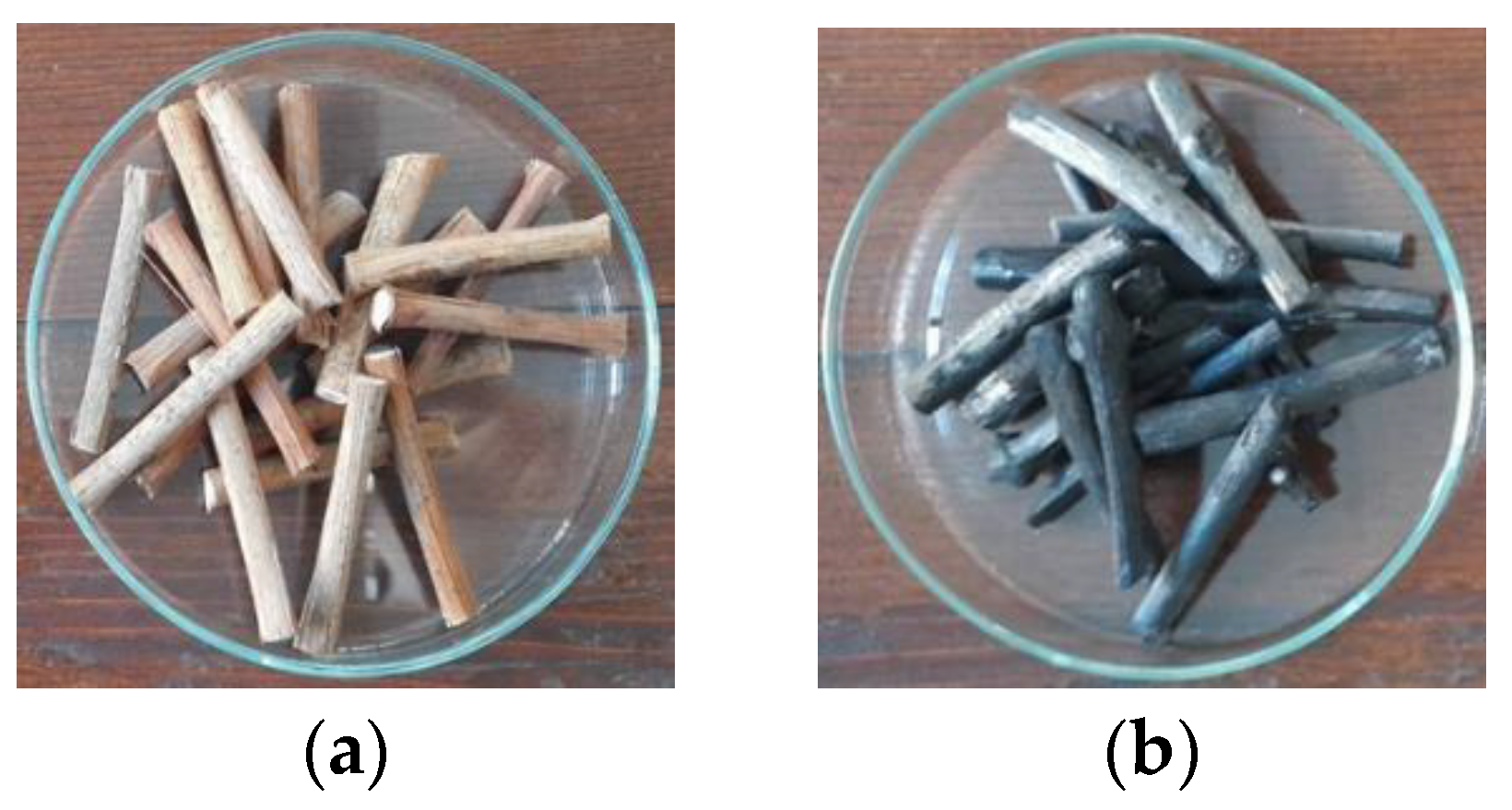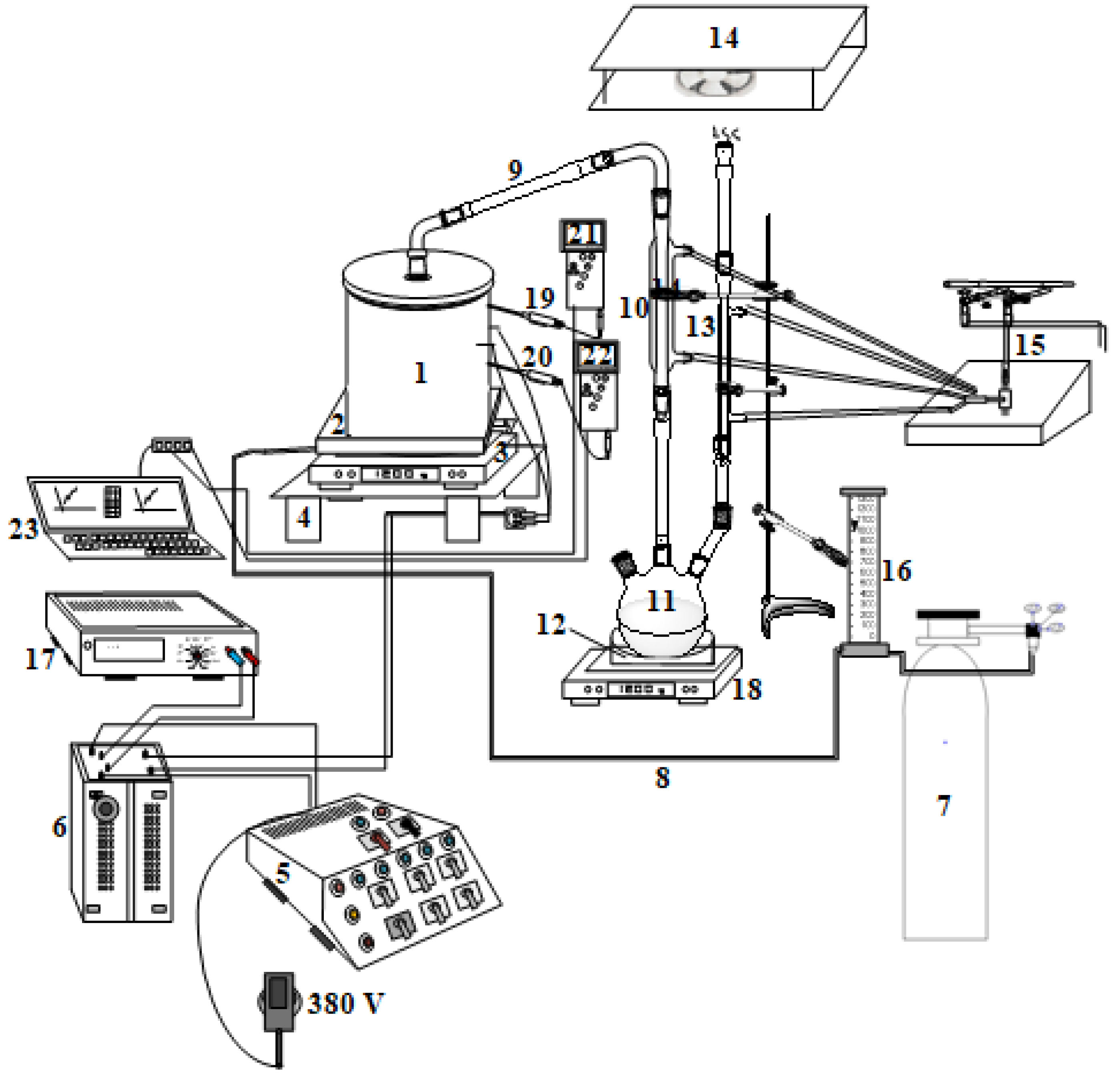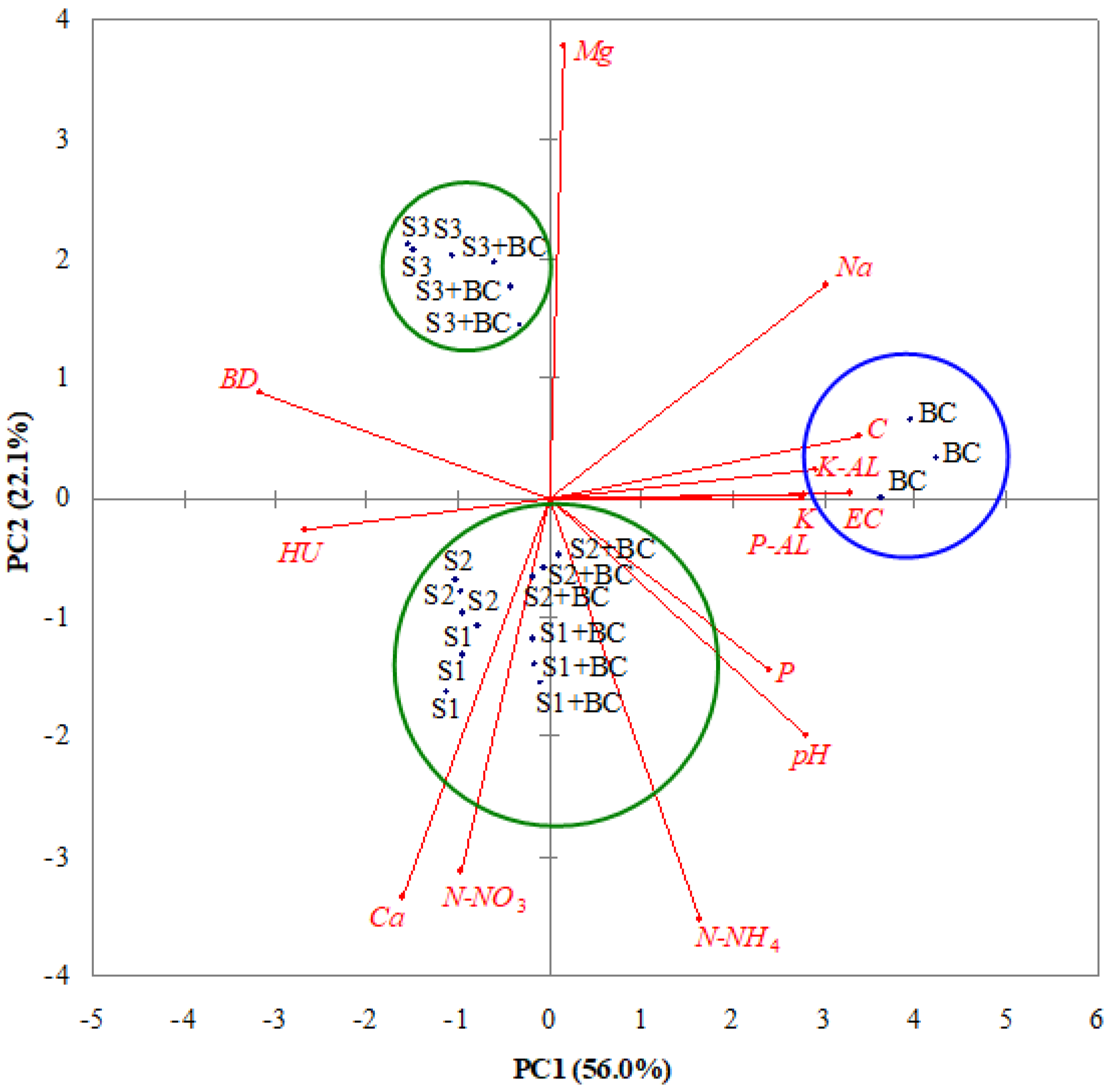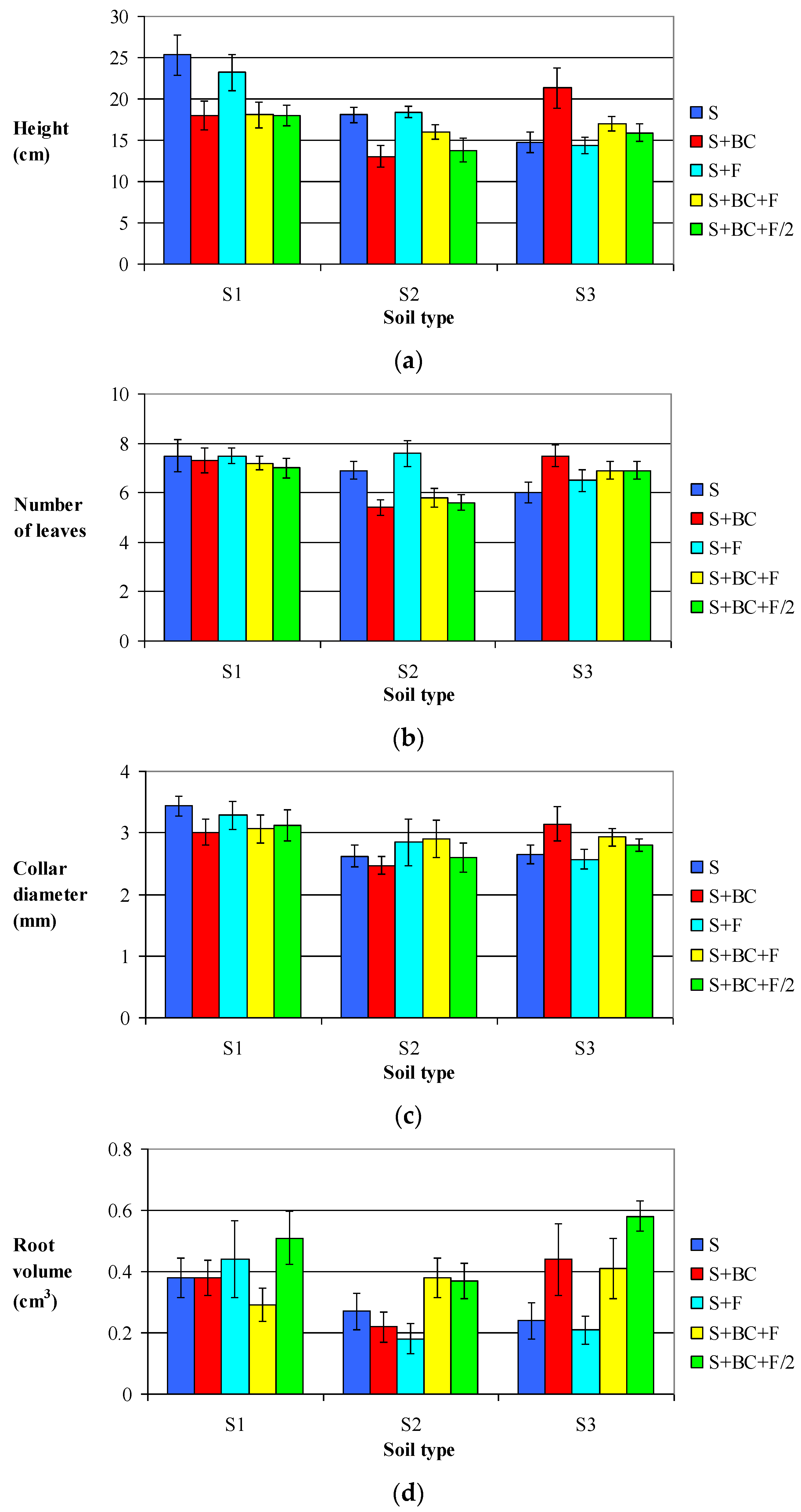Effects of Biochar on Soil Properties and Tomato Growth
Abstract
:1. Introduction
2. Materials and Methods
2.1. Materials
2.1.1. Production of BC
2.1.2. Preparation of BC-Amended Soils
2.2. Equipment, Procedures, and Variables
2.2.1. Production of BC
2.2.2. Characterization of Non-Amended Soils, BC Amendment, and BC-Amended Soils
2.2.3. Effects of BC Amendment on Tomato Growth
2.3. Statistical Analysis
3. Results
3.1. Characterization of Non-Amended Soils, the BC Amendment, and BC-Amended Soils
- the values of humidity (HU), bulk density (BD), soluble nitrate nitrogen concentration (N-NO3), and available calcium concentration (Ca) are higher for non-amended soils than for BC (3–4 times for HU and BD, 2–6 times for N-NO3, 16–46% for Ca) and BC-amended soils (6–19% for HU, 16–50% for BD, 15–32% for N-NO3, 7–20% for Ca);
- the values of pH, electrical conductivity (EC), total carbon concentration (C), concentrations of soluble ammonium nitrogen (N-NH4), soluble phosphorus and potassium (P and K), available phosphorus and potassium (P-AL and K-AL), and available sodium (Na) are lower for non-amended soils than for BC (24–83% for pH, 9–22 times for EC, 26–38 times for C, up to 5 times for N-NH4, 3–21 times for P, 131–567 times for K, 16–128 times for P-AL, 23–41 times for K-AL, and 2–3 times for Na) and BC-amended soils (4–19% for pH, about 2 times for EC, 4–7 times for C, 10–26% for N-NH4, 2–7 times for P, 6–24 times for K, 2–10 times for P-AL, 3–4 times for K-AL, and up to 13% for Na);
- the values of available magnesium concentration (Mg) are higher for non-amended soil 3 than for BC (by 28%) and BC-amended soil 3 (by 4%); compared to non-amended soils S1 and S2, the values of Mg are higher for BC (up to 53%) as well as for BC-amended soils S1 and S2 (up to 8%).
- BC amendment has higher levels of C (76.01 ± 0.68%), EC (2.04 ± 0.07 dS/m), pH (9.89 ± 0.01), K-AL (8200 ± 0 mg/kg), P-AL (1615 ± 7 mg/kg), K (3131 ± 183 mg/kg), P (16.0 ± 0.3 mg/kg), and Na (87.9 ± 7.0 mg/kg), but lower levels of BD (0.319 ± 0.018 g/cm3) and HU (3.51 ± 0.18%) than other samples [discrimination on PC1 between BC (blue circle) and the other samples];
- non-amended soil 3 (S3) and BC-amended soil 3 (S3 + BC) have higher levels of Mg (572.2–607.5 mg/kg) and lower levels of N-NO3 (8.0–9.7 mg/kg), N-NH4 (2.8–4.1 mg/kg), and Ca (2182–2373 mg/kg) than the other non-amended and BC-amended soils (Mg = 302.6–388.1 mg/kg, N-NO3 = 10.6–32.8 mg/kg, N-NH4 = 11.0–14.1 mg/kg, and Ca = 2415–3035 mg/kg) [discrimination on PC2 between S3 and S3 + BC and the other non-amended and BC-amended soils (green circles)];
- pH, EC, C, N-NH4, P, K, P-AL, K-AL, and Na are directly correlated and they are inversely correlated with HU, BD, N-NO3, and Ca;
- there are very strong positive correlations (r ≥ 0.85) between EC and C (r = 0.97), Na and C (r = 0.94), Na and EC (r = 0.88);
- there are very strong negative correlations between BD and C (r = −0.89), HU and K-AL (r = −0.87), BD and EC (r = −0.86), BD and pH (r = −0.85).
3.2. Effects of BC Amendment on Tomato Growth
4. Discussion
5. Conclusions
Supplementary Materials
Author Contributions
Funding
Institutional Review Board Statement
Informed Consent Statement
Data Availability Statement
Conflicts of Interest
References
- Haider, F.U.; Coulter, J.A.; Liqun, C.A.I.; Hussain, S.; Cheema, S.A.; Jun, W.U.; Zhang, R. An overview on biochar production, its implications, and mechanisms of biochar-induced amelioration of soil and plant characteristics. Pedosphere 2022, 32, 107–130. [Google Scholar] [CrossRef]
- Malyan, S.K.; Kumar, S.S.; Fagodiya, R.K.; Ghosh, P.; Kumar, A.; Singh, R.; Singh, L. Biochar for environmental sustainability in the energy-water-agroecosystem nexus. Renew. Sust. Energ. Rev. 2021, 149, 111379. [Google Scholar] [CrossRef]
- Rehman, I.; Riaz, M.; Ali, S.; Arif, M.S.; Ali, S.; Alyemeni, M.N.; Alsahli, A.A. Evaluating the effects of biochar with farmyard manure under optimal mineral fertilizing on tomato growth, soil organic C and biochemical quality in a low fertility soil. Sustainability 2021, 13, 2652. [Google Scholar] [CrossRef]
- Wu, P.; Ata-Ul-Karim, S.T.; Singh, B.P.; Wang, H.; Wu, T.; Liu, C.; Fang, G.; Zhou, D.; Wang, Y.; Chen, W. A scientometric review of biochar research in the past 20 years (1998–2018). Biochar 2019, 1, 23–43. [Google Scholar] [CrossRef] [Green Version]
- Yuan, P.; Wang, J.; Pan, Y.; Shen, B.; Wu, C. Review of biochar for the management of contaminated soil: Preparation, application and prospect. Sci. Total Environ. 2019, 659, 473–490. [Google Scholar] [CrossRef] [PubMed]
- Hussain, M.; Farooq, M.; Nawaz, A.; Al-Sadi, A.M.; Solaiman, Z.M.; Alghamdi, S.S.; Ammara, U.; Ok, Y.S.; Siddique, K.H. Biochar for crop production: Potential benefits and risks. J. Soils Sediments 2017, 17, 685–716. [Google Scholar] [CrossRef]
- Irfan, M.R.; Kaleri, F.N.; Rizwan, M.; Mehmood, I. Potential value of biochar as a soil amendment: A review. Pure Appl. Biol. 2017, 6, 1494–1502. Available online: https://thepab.org/index.php/journal/article/view/296 (accessed on 1 July 2022). [CrossRef]
- Mohawesh, O.; Albalasmeh, A.; Gharaibeh, M.; Deb, S.; Simpson, C.; Singh, S.; Al-Soub, B.; Hanandeh, A.E. Potential use of biochar as an amendment to improve soil fertility and tomato and bell pepper growth performance under arid conditions. J. Soil Sci. Plant Nutr. 2021, 21, 2946–2956. [Google Scholar] [CrossRef]
- Olmo, M.; Alburquerque, J.A.; Barrón, V.; Del Campillo, M.C.; Gallardo, A.; Fuentes, M.; Villar, R. Wheat growth and yield responses to biochar addition under Mediterranean climate conditions. Biol. Fertil. Soils 2014, 50, 1177–1187. [Google Scholar] [CrossRef]
- Vaccari, F.P.; Maienza, A.; Miglietta, F.; Baronti, S.; Di Lonardo, S.; Giagnoni, L.; Lagomarsino, A.; Pozzi, A.; Pusceddu, E.; Ranieri, R.; et al. Biochar stimulates plant growth but not fruit yield of processing tomato in a fertile soil. Agric. Ecosyst. Environ. 2015, 207, 163–170. [Google Scholar] [CrossRef]
- Ye, L.; Camps-Arbestain, M.; Shen, Q.; Lehmann, J.; Singh, B.; Sabir, M. Biochar effects on crop yields with and without fertilizer: A meta-analysis of field studies using separate controls. Soil Use Manag. 2020, 36, 2–18. [Google Scholar] [CrossRef]
- Agbna, H.D.; Ali, G.; Albashir, E.; Mohammed, M.; Bakir, M.; Osman, A.; Elshaikh, A. Effect of biochar on some soil properties and tomato growth under saline water conditions. Int. J. Sci. Eng. Res. 2017, 8, 24–28. [Google Scholar]
- Alkharabsheh, H.M.; Seleiman, M.F.; Battaglia, M.L.; Shami, A.; Jalal, R.S.; Alhammad, B.A.; Almutairi, K.F.; Al-Saif, A.M. Biochar and its broad impacts in soil quality and fertility, nutrient leaching and crop productivity: A review. Agronomy 2021, 11, 993. [Google Scholar] [CrossRef]
- Altland, J.E.; Locke, J.C. High rates of gasified rice hull biochar affect geranium and tomato growth in a soilless substrate. J. Plant Nutr. 2017, 40, 1816–1828. [Google Scholar] [CrossRef]
- Chen, W.; Meng, J.; Han, X.; Lan, Y.; Zhang, W. Past, present, and future of biochar. Biochar 2019, 1, 75–87. [Google Scholar] [CrossRef] [Green Version]
- Diatta, A.A.; Fike, J.H.; Battaglia, M.L.; Galbraith, J.M.; Baig, M.B. Effects of biochar on soil fertility and crop productivity in arid regions: A review. Arab. J. Geosci. 2020, 13, 595. [Google Scholar] [CrossRef]
- Jha, P.; Biswas, A.K.; Lakaria, B.L.; Rao, A.S. Biochar in agriculture–prospects and related implications. Curr. Sci. 2010, 99, 1218–1225. Available online: https://www.jstor.org/stable/24068517 (accessed on 1 July 2022).
- Khan, M.N.; Lan, Z.; Sial, T.A.; Zhao, Y.; Haseeb, A.; Jianguo, Z.; Zhang, A.; Hill, R.L. Straw and biochar effects on soil properties and tomato seedling growth under different moisture levels. Arch. Agron. Soil Sci. 2019, 65, 1704–1719. [Google Scholar] [CrossRef]
- Murtaza, G.; Ahmed, Z.; Usman, M.; Tariq, W.; Ullah, Z.; Shareef, M.; Iqbal, H.; Waqas, M.; Tariq, A.; Wu, Y.; et al. Biochar induced modifications in soil properties and its impacts on crop growth and production. J. Plant Nutr. 2021, 44, 1677–1691. [Google Scholar] [CrossRef]
- Schmidt, H.P.; Kammann, C.; Hagemann, N.; Leifeld, J.; Bucheli, T.D.; Sánchez Monedero, M.A.; Cayuela, M.L. Biochar in agriculture–A systematic review of 26 global meta-analyses. Glob. Change Biol. Bioenergy 2021, 13, 1708–1730. [Google Scholar] [CrossRef]
- Suthar, R.G.; Wang, C.; Nunes, M.C.N.; Chen, J.; Sargent, S.A.; Bucklin, R.A.; Gao, B. Bamboo biochar pyrolyzed at low temperature improves tomato plant growth and fruit quality. Agriculture 2018, 8, 153. [Google Scholar] [CrossRef] [Green Version]
- Bonanomi, G.; Ippolito, F.; Cesarano, G.; Nanni, B.; Lombardi, N.; Rita, A.; Saracino, A.; Scala, F. Biochar as plant growth promoter: Better off alone or mixed with organic amendments? Front. Plant Sci. 2017, 8, 1570. [Google Scholar] [CrossRef] [PubMed]
- Jones, D.L.; Rousk, J.; Edwards-Jones, G.; DeLuca, T.H.; Murphy, D.V. Biochar-mediated changes in soil quality and plant growth in a three year field trial. Soil Biol. Biochem. 2012, 45, 113–124. [Google Scholar] [CrossRef]
- Ronga, D.; Caradonia, F.; Parisi, M.; Bezzi, G.; Parisi, B.; Allesina, G.; Pedrazzi, S.; Francia, E. Using digestate and biochar as fertilizers to improve processing tomato production sustainability. Agronomy 2020, 10, 138. [Google Scholar] [CrossRef] [Green Version]
- Graber, E.R.; Meller, H.Y.; Kolton, M.; Cytryn, E.; Silber, A.; Rav David, D.; Tsechansky, L.; Borenshtein, M.; Elad, Y. Biochar impact on development and productivity of pepper and tomato grown in fertigated soilless media. Plant Soil 2010, 337, 481–496. [Google Scholar] [CrossRef]
- Guo, L.; Yu, H.; Kharbach, M.; Zhang, W.; Wang, J.; Niu, W. Biochar improves soil-tomato plant, tomato production, and economic benefits under reduced nitrogen application in northwestern China. Plants 2021, 10, 759. [Google Scholar] [CrossRef]
- Schulz, H.; Glaser, B. Effects of biochar compared to organic and inorganic fertilizers on soil quality and plant growth in a greenhouse experiment. J. Plant. Nutr. Soil Sci. 2012, 175, 410–422. [Google Scholar] [CrossRef]
- Calcan, S.I.; Pârvulescu, O.C.; Ion, V.A.; Răducanu, C.E.; Bădulescu, L.; Dobre, T.; Egri, D.; Moț, A.; Popa, V.; Crăciun, M.E. Valorization of vine prunings by slow pyrolysis in a fixed-bed reactor. Processes 2022, 10, 37. [Google Scholar] [CrossRef]
- Dobre, T.; Pârvulescu, O.C.; Iavorschi, G.; Stoica, A.; Stroescu, M. Catalytic effects at pyrolysis of wheat grains impregnated with nickel salts. Int. J. Chem. React. Eng. 2010, 8, 1968–1992. [Google Scholar] [CrossRef]
- Dobre, T.; Pârvulescu, O.C.; Rodriguez, R.I.; Ceatră, L.; Stroescu, M.; Stoica, A.; Mirea, R. Global reaction kinetics and enthalpy in slow pyrolysis of vegetal materials. Rev. Chim. 2012, 63, 54–59. [Google Scholar]
- Pârvulescu, O.C.; Dobre, T.; Ceatră, L.; Iavorschi, G.; Mirea, R. Characteristics of corn grains pyrolysis in a fixed bed reactor. Rev. Chim. 2011, 62, 89–94. [Google Scholar]
- Pârvulescu, O.C.; Gavrilă, A.I.; Dobre, T.; Ceatră, L. Effects of process factors on slow pyrolysis of sorghum waste. Rev. Chim. 2016, 67, 2254–2257. [Google Scholar]
- Jesus, M.; Romaní, A.; Mata, F.; Domingues, L. Current options in the valorisation of vine pruning residue for the production of biofuels, biopolymers, antioxidants, and bio-composites following the concept of biorefinery: A review. Polymers 2022, 14, 1640. [Google Scholar] [CrossRef] [PubMed]
- Ion, V.A.; Moț, A.; Popa, V.I.; Calcan, S.; Bădulescu, L.; Jerca, I.O.; Baniţă, C.; Pârvulescu, O.C. Physicochemical characterisation of vine waste used for producing biochar. Sci. Papers Ser. B Hortic. 2021, LXV, 268–273. [Google Scholar]
- Nasser, R.A.; Salem, M.Z.M.; Al-Mefarrej, H.A.; Abdel-Aal, M.A.; Soliman, S.S. Fuel characteristics of vine prunings (Vitis vinifera L.) as a potential source for energy production. BioResources 2014, 9, 482–496. [Google Scholar] [CrossRef] [Green Version]
- Ceatră, L.; Pârvulescu, O.C.; Rodriguez, R.I.; Dobre, T. Preparation, characterization, and testing of a carbon-supported catalyst obtained by slow pyrolysis of nickel salt impregnated vegetal material. Ind. Eng. Chem. Res. 2016, 55, 1491–1502. [Google Scholar] [CrossRef]
- FAO; IUSS Working Group WRB. World Reference Base for Soil Resources. In International Soil Classification System for Naming Soils and Creating Legends for Soil Maps, World Soil Resources Reports No. 106; FAO: Rome, Italy, 2015. [Google Scholar]
- Mușat, M.; Radu, A.; Madjar, R. Pedological and agrochemical study at SC Agrilemi SRL, to develop fertilization plan on culture. Sci. Papers Ser. A Agron. 2017, LX, 132–136. [Google Scholar]
- Crăciun, M.E.; Pârvulescu, O.C.; Donise, A.C.; Dobre, T.; Stanciu, D.R. Characterization and classification of Romanian acacia honey based on its physicochemical parameters and chemometrics. Sci. Rep. 2020, 10, 20690. [Google Scholar] [CrossRef] [PubMed]
- Pasztor, R.; Bala, M.; Sala, F. Flowers quality in relation to planting period in some Hyacinth cultivars. AgroLife Sci. J. 2020, 9, 263–272. [Google Scholar]





| No. | Treatment | Code |
|---|---|---|
| 1 | No BC and foliar fertilizer treatments | S |
| 2 | BC (volumetric ratio between BC and soil of 20/80) | S + BC |
| 3 | Foliar fertilizer (0.2%) | S + F |
| 4 | BC + foliar fertilizer (0.2%) | S + BC + F |
| 5 | BC + foliar fertilizer (0.1%) | S + BC + F/2 |
| No. | Property | S1 | S2 | S3 | BC | S1 + BC | S2 + BC | S3 + BC |
|---|---|---|---|---|---|---|---|---|
| 1 | HU (%) | 14.69 | 10.43 | 13.10 | 3.51 | 12.33 | 9.60 | 12.36 |
| 2 | BD (g/cm3) | 1.054 | 0.986 | 1.314 | 0.319 | 0.799 | 0.851 | 0.873 |
| 3 | pH | 7.99 | 6.26 | 5.40 | 9.89 | 8.33 | 7.10 | 6.45 |
| 4 | EC (dS/m) | 0.22 | 0.10 | 0.09 | 2.04 | 0.35 | 0.21 | 0.16 |
| 5 | C (%) | 2.89 | 2.01 | 1.98 | 76.01 | 10.99 | 10.26 | 14.35 |
| 6 | N-NO3 (mg/kg) | 31.2 | 14.9 | 9.2 | 5.4 | 26.2 | 11.3 | 8.0 |
| 7 | N-NH4 (mg/kg) | 11.9 | 11.3 | 3.0 | 15.6 | 13.9 | 12.4 | 3.7 |
| 8 | P (mg/kg) | 6.3 | 2.3 | 0.8 | 16.0 | 13.6 | 14.7 | 2.9 |
| 9 | K (mg/kg) | 23.9 | 5.5 | 6.4 | 3131 | 132.0 | 130.1 | 51.1 |
| 10 | P-AL (mg/kg) | 103.6 | 16.4 | 12.7 | 1615 | 226.7 | 168.7 | 86.7 |
| 11 | K-AL (mg/kg) | 360 | 200 | 240 | 8200 | 1040 | 860 | 700 |
| 12 | Ca (mg/kg) | 2990 | 2940 | 2366 | 2044 | 2763 | 2443 | 2202 |
| 13 | Mg (mg/kg) | 371.9 | 308.3 | 605.9 | 472.2 | 386.6 | 334.4 | 582.7 |
| 14 | Na (mg/kg) | 31.1 | 31.0 | 44.9 | 87.9 | 35.3 | 34.7 | 50.5 |
| Variables | HU | BD | pH | EC | C | N-NO3 | N-NH4 | P | K | P-AL | K-AL | Ca | Mg | Na |
|---|---|---|---|---|---|---|---|---|---|---|---|---|---|---|
| HU | 1 | |||||||||||||
| BD | 0.69 | 1 | ||||||||||||
| pH | −0.49 | −0.85 | 1 | |||||||||||
| EC | −0.68 | −0.86 | 0.81 | 1 | ||||||||||
| C | −0.73 | −0.89 | 0.77 | 0.97 | 1 | |||||||||
| N-NO3 | 0.30 | 0.14 | 0.25 | −0.25 | −0.34 | 1 | ||||||||
| N-NH4 | −0.33 | −0.59 | 0.70 | 0.42 | 0.37 | 0.31 | 1 | |||||||
| P | −0.53 | −0.72 | 0.70 | 0.55 | 0.61 | 0.00 | 0.62 | 1 | ||||||
| K | −0.49 | −0.72 | 0.63 | 0.81 | 0.82 | −0.37 | 0.49 | 0.51 | 1 | |||||
| P-AL | −0.45 | −0.75 | 0.71 | 0.83 | 0.83 | −0.16 | 0.29 | 0.57 | 0.56 | 1 | ||||
| K-AL | −0.87 | −0.73 | 0.67 | 0.80 | 0.82 | −0.20 | 0.34 | 0.49 | 0.52 | 0.55 | 1 | |||
| Ca | 0.50 | 0.32 | −0.03 | −0.36 | −0.52 | 0.64 | 0.42 | −0.21 | −0.23 | −0.32 | −0.51 | 1 | ||
| Mg | 0.09 | 0.18 | −0.25 | 0.07 | 0.17 | −0.45 | −0.72 | −0.23 | 0.09 | 0.11 | 0.02 | −0.65 | 1 | |
| Na | −0.66 | −0.72 | 0.56 | 0.88 | 0.94 | −0.50 | 0.09 | 0.42 | 0.79 | 0.69 | 0.74 | −0.67 | 0.45 | 1 |
Publisher’s Note: MDPI stays neutral with regard to jurisdictional claims in published maps and institutional affiliations. |
© 2022 by the authors. Licensee MDPI, Basel, Switzerland. This article is an open access article distributed under the terms and conditions of the Creative Commons Attribution (CC BY) license (https://creativecommons.org/licenses/by/4.0/).
Share and Cite
Calcan, S.I.; Pârvulescu, O.C.; Ion, V.A.; Răducanu, C.E.; Bădulescu, L.; Madjar, R.; Dobre, T.; Egri, D.; Moț, A.; Iliescu, L.M.; et al. Effects of Biochar on Soil Properties and Tomato Growth. Agronomy 2022, 12, 1824. https://doi.org/10.3390/agronomy12081824
Calcan SI, Pârvulescu OC, Ion VA, Răducanu CE, Bădulescu L, Madjar R, Dobre T, Egri D, Moț A, Iliescu LM, et al. Effects of Biochar on Soil Properties and Tomato Growth. Agronomy. 2022; 12(8):1824. https://doi.org/10.3390/agronomy12081824
Chicago/Turabian StyleCalcan, Suzana Ioana, Oana Cristina Pârvulescu, Violeta Alexandra Ion, Cristian Eugen Răducanu, Liliana Bădulescu, Roxana Madjar, Tănase Dobre, Diana Egri, Andrei Moț, Lavinia Mihaela Iliescu, and et al. 2022. "Effects of Biochar on Soil Properties and Tomato Growth" Agronomy 12, no. 8: 1824. https://doi.org/10.3390/agronomy12081824
APA StyleCalcan, S. I., Pârvulescu, O. C., Ion, V. A., Răducanu, C. E., Bădulescu, L., Madjar, R., Dobre, T., Egri, D., Moț, A., Iliescu, L. M., & Jerca, I. O. (2022). Effects of Biochar on Soil Properties and Tomato Growth. Agronomy, 12(8), 1824. https://doi.org/10.3390/agronomy12081824







